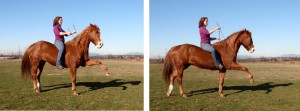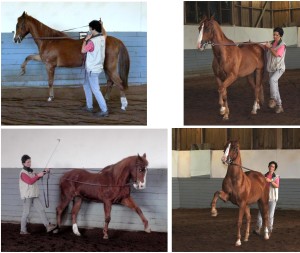Long-reining – Part 11
|
|
Arbeit am langen Zügel – Teil 11
|
- In the last part we worked on the Pirouette and the half-pass. Practising this takes a long time and was (at least in my case) at times quite frustrating. Even after Beau had understood the Travers quite well when performed along the wall, we still had problems with the half-pass. Either he lost the bend and walked on a straight diagonal across the arena, or he stepped sideways and lost the forward movement. As always one side was harder than the other (his right) – and in trot the whole thing fell part…
We needed cheering up!
- So, if you are encountering similar problems, recall that we are long-reining for FUN! And the rule for good training along the lines of H.E.M. (Help, Explain and Motivate) is that when something ceases to be fun, you must change the program to re-establish motivation!
The Spanish Step: a great motivator!
- If you are giving the training games of my book “From Leading to Liberty” a try, then you will find out that the Spanish Step (Game 71 on page 270) is a great motivator! Since in nature it is a playful gesture, it makes horses happy. Look at the scenes shown in my film “Playing with Horses” and you will see that horses can play this game of teasing each other with a lot of enthusiasm and for quite a length of time.
|
|
- Im letzten Teil haben wir an der Pirouette und der Traversale gearbeitet. Das zu üben benötigt Zeit und kann (zumindest in meinem Fall) manchmal ganz schön frustrierend sein. Sogar nachdem Beau das Travers entlang der Wand schon gut zeigen konnte, hatte er mit der Traversale immer noch große Probleme. Entweder er gab die Biegung auf und ging auf einer Geraden diagonal durch die Halle, oder er verlor die Vorwärtsbewegung und driftete seitlich davon. Wie immer war auch eine Seite viel schwieriger als die andere (bei ihm rechts) – und im Trab fiel dann alles endgültig auseinander…
Wir brauchten Aufheiterung!
- Sollten Sie ähnliche Probleme haben, dann vergessen Sie nicht, daß wir zum SPASS am langen Zügel spielen! Und die Regel für jedes gute Training nach meiner H.E.M. Methode (Helfen, Erklären und Motivieren) ist ja, daß man, wenn der Spaß verloren geht, das Programm ändern und die Motivation wiederbeleben muß!
Er spanische Schritt ist eine tolle Motivation!
- Wenn Sie die Spiele in meinem Buch “From Leading to Liberty“ ausprobieren, dann finden Sie schnell heraus, daß der spanische Schritt (Spiel 71 auf Seite 270) sehr motivierend ist! Da er in der Natur eine spielerische Geste ist, macht er Pferde glücklich. Schauen Sie im meinem Film “Playing with Horses” (auch deutsch!) die Szene an, wie die Pferde sich gegenseitig begeistert und lange damit necken.
|
 Left: help with body language – synchronize !
Mid: train for nice elevation – determined touching aid!
Right: train for extension – keep moving! |
The Spanish Walk on the long-reins:
- On the long reins this can be quite a showy performance – BUT the horse must have understood your commands “in hand”, from the position in front of him, then by his side, BEFORE you can call it off on the long reins in the position behind the horse.
Teach it in small increments:
- So here I must refer you to my book and film to get the step by step instruction. There you will learn how to progress from touching aids with the whip (reinforced by your body language) to rein aids, accompanied by leg aids when you ride, which are of course all reinforced by voice command and praise.
|
|
Der spanische Schritt am langen Zügel:
- Am langen Zügel kann das toll aussehen – ABER das Pferd muß die Kommandos zuerst an der Hand gelernt haben, BEVOR Sie es am langen Zügel von hinter dem Pferd verlangen können.
In kleine Lernschritte zerlegen:
- Hier muß ich Sie für die schrittweisen Anleitungen an mein Buch und meine Filme verweisen. Da lernt man, wie man von den Touchierhilfen mit der Gerte (durch Körpersprache unterstützt), auf Zügelhilfen umleitet, begleitet von Hilfen mit dem Bein, wenn man reitet – und alles natürlich bestärkt mit Stimmhilfen und Lob.
|
 Left: first standing still – the horse learns to react to the alternating touching aid on his shoulders. Touching on both sides simultaneously is wrong!
Right: in motion you also give a leg aid on the side, where you want the lift. Later this will be refined so it is hardly visible. |
- Once you are in the position behind the horse you can only apply slight rein aids (because you cannot lift them significantly from this position) and rely largely on voice – and the previous understanding and willingness of your horse for performing the Spanish Walk.
|
|
- Wenn man sich dann in der Position hinter dem Pferd befindet, kann man nur noch leichte Zügelhilfen anwenden (man kann sie von dort aus ja nicht sehr hoch heben) und muß sich weitgehend auf Stimme verlassen – und das schon erlernte Verständnis und die Bereitschaft des Pferdes den spansichen Schritt zeigen zu wollen.
|
 Insist on a fluid forward movement with good rhythm. The horse should not stomp a hole into the ground, but rather step actively with his hind legs all the time. |
- The horse must have learned from you “in hand” the various ingredients for a good Spanish Walk. Remember that you can at any one time only train for ONE aspect of an exercise (review the ten laws of shaping!!), otherwise the horse will get confused.
- First he needs to understand the meaning of the touching aid. The intensity will vary according to the reaction you want.
- Then he needs to get going – not stamp a hole into the ground, as he likely did very proudly in the beginning. Most of this training will happen with you walking backward in the front of your horse. But you can also help by synchronizing with your horse from the side as shown on the left of the first picture – this can help the horse greatly in his understanding of what you want!
- Then you need to establish a good rhythm.
- After your horse has understood the basics, you can ride the Spanish Step – see the second picture. In this case you add a leg aid to the touching aid to indicate where you request the lift.
|
|
- Das Pferd muß von Ihnen an der Hand schon die verschiedenen Bestandteile für einen guten spanischen Schritt gelernt haben. Vergessen Sie nicht, daß Sie zu jedem Zeitpunkt nur EINEN Aspekt der Übung trainieren dürfen (lesen Sie nochmals die zehn Gebote des Formens!!), sonst verwirren Sie Ihr Pferd.
- Zuerst muß es die Bedeutung der Touchierhilfe verstehen. Die Intensität wird sich je nach der gewünschten Reaktion ändern.
- Dann muß es vorwärts gehen – es soll nicht, wie es vermutlich anfangs anbot, stolz Löcher in den Boden stampfen. Zuerst wird die Ausbildung hauptsächlich von vorne passieren, indem Sie rückwärts schreiten. Man kann dem besseren Verständnis aber auch nachhelfen, indem man sich daneben mit seinem Pferd synchronisiert, wie im ersten Bild links gezeigt – das kann dem Pferd für ein Verstehen von großem Nutzen sein!
- Dann müssen Sie einen guten Rhythmus einführen. Nachdem das Pferd das Wesentliche begriffen hat, kann man den spanischen Schritt auch reiten – siehe zweites Foto. In dem Fall kommt zu der Touchierhilfe noch eine Andeutung mit dem Bein dazu, wenn man das Anheben verlangt.
|
 If you want the horse to step with expression, you must move rhythmically and energetically yourself.
By making himself light on the forehand, the horse will tend to collect himself naturally. |
The timing of aids is essential!
- All aids must be perfectly timed, and this often proves to be the hardest thing for the human to learn. If you give an aid at the moment, when the horse has weight on the respective leg, then he can of course not fulfil your request!!
Pre-requisites fulfilled:
- After the horse has learned those ingredients you can progress to the Spanish Step on the long reins.
|
|
Das Timing der Hilfen ist wesentlich!
- Alle Hilfen müssen perfekt im Timing sein, was oft für den Menschen die größte Schwierigkeit darstellt. Wenn Sie die Hilfen in dem Moment geben, in dem das Pferd auf das betreffende Bein Gewicht legt, kann es Ihrem Wunsch nach einem Anheben natürlich nicht nachkommen!!
Alle Voraussetzungen erfüllt:
- Nachdem das Pferd alle diese Bestandteile erlernt hat, kann man den spanischen Schritt am langen Zügel versuchen.
|
 Top left: lift the rein clearly to indicate the request for the leg lift.
Top right: synchronize and help with body language – he can see your movement!
Bottom: keep a good rhythm going and use voice command “and STEP!” Praise a lot!! |
- First walking next to the horse, you indicate the requested leg lift by a clear lifting of the rein. Start teaching him on the inside, then you can also apply a whip aid if needed for clarification. In the picture on the top left Beau already performs on voice aid and rein lift only.
- In the picture on the top right you see that even on the long reins I help the horse by synchronisation. As his vision is almost 360 degrees, he can see my motion back there, if I step slightly to the side!
- On the bottom left you can again observe how the horse begins to collect naturally, because the exercise teaches him to make himself light on the forehand. So the Spanish Walk is not only a great motivator, since all horses seem to love it, but also a great training tool for all dressage training. The people who pooh-pooh it as a mere trick really do not know what they are missing!
- On the bottom right you see Beau in all his pride: he performs a beautiful, proud Spanish Step in good rhythm, on a straight line, energetic but calm, and on voice aid and a very slight vibration of the rein only.
Give it a try! See if it doesn’t motivate your horse! Read on!! |
|
- Zuerst geht man wieder neben dem Pferd und verlangt ein Beinheben mit einem klaren Anheben des Zügels.
- Tun Sie das zuerst auf der inneren Seite, damit Sie ebenfalls eine Gertenhilfe geben können, falls das zur Klarstellung nötig ist. In dem Foto oben links macht Beau den spanischen Schritt schon auf Stimm- und Zügelhilfen allein.
- Im Bild oben rechts sehen Sie, daß ich auch am langen Zügel dem Pferd mit Synchronisieren nachhelfe. Da es ja ein Blickfeld von fast 360 Grad hat, kann es meine Bewegungen da hinten durchaus sehen, wenn ich leicht zur Seite trete!
- Unten links sieht man, wie das Pferd anfängt sich ganz natürlich zu versammeln, da diese Übung ihm beibringt, sich auf der Vorhand leichter zu machen. Damit ist der spanische Schritt nicht nur sehr motivierend, sondern auch ein großartiges Trainingsinstrument für jegliche Dressur. Die Leute, die ihn als bloßen „Trick“ abtun, haben echt keine Ahnung, was sie verpassen!
- Unten rechts sehen Sie Beau ganz stolz: er führt den spanischen Schritt wunderschön aus, mit stolzem Gesichtsausdruck, in gutem Rhythmus und auf einer geraden Linie, energisch aber ruhig, auf Stimmhilfe und ganz leichte Vibration eines Zügels.
Versuchen Sie es! Sie werden sehen wie sehr es Ihr Pferd motiviert! Lesen Sie weiter!! |






